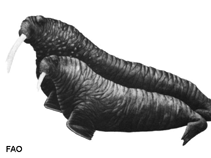Odobenus rosmarus (Linnaeus, 1758)
Walrus| Native range | All suitable habitat | Point map | Year 2050 |

|
| This map was computer-generated and has not yet been reviewed. |
| Odobenus rosmarus AquaMaps Data sources: GBIF OBIS |
Classification / Names Common names | Synonyms | CoL | ITIS | WoRMS
Mammalia | Carnivora | Odobenidae
Environment: milieu / climate zone / depth range / distribution range Ecology
Bathydemersal; depth range ? - 91 m (Ref. 124244). Temperate; 90°N - 0°S, 180°W - 180°E
Distribution Countries | FAO areas | Ecosystems | Occurrences | Introductions
Atlantic Ocean, Northern Pacific, and the Arctic. Greenland, Canada, Norway, Alaska, Russia (Ref. 1394), Iceland, UK, Netherlands, Belgium, Japan, Beaufort Sea, Sea of Okhotsk, Bering Sea, Chukchi Sea, Atlantic Ocean, Barents Sea, Arctic Ocean, Laptev Sea, Hudson Bay, Kara Sea, East Barents Sea, East Siberian Sea, Kamchatka, Celtic-Biscay Shelf (Ref. 1522); Odobenus rosmarus rosmarus: Russia, Canada, Greenland, Iceland, Norway, UK, Barents Sea, Netherlands, Belgium, Atlantic Ocean, Bay of Biscay, Hudson Bay, Kara Sea, Prince Edward Island; Odobenus rosmarus laptevi: Russia, Laptev Sea, Kara Sea, East Siberian Sea; Odobenus rosmarus divergens: Arctic Ocean, Bering Sea, Chukchi Sea, Alaska, Russia, Beaufort Sea, Sea of Okhotsk, Japan, Kamchatka.
Length at first maturity / Size / Weight / Age
Maturity: Lm ? range ? - ? cm Max length : 380 cm TL male/unsexed; (Ref. 99323); 300 cm TL (female); max. published weight: 1.9 t (Ref. 99323); max. published weight: 1.9 t
Found in shallow water and coastal habitats, usually associated with pack ice; regularly haul out on sandy beaches, rocky shores, and ice floes to rest and moult. Feeds on benthic invertebrates (i.e. clams, worms, snails, shrimp and slow-moving fish). Maximum measurements of female species based from Ref. 1394.
Life cycle and mating behavior Maturity | Reproduction | Spawning | Eggs | Fecundity | Larvae
Main reference
References | Coordinator | Collaborators
Jefferson, T.A., S. Leatherwood and M.A. Webber. 1993. (Ref. 1394)
IUCN Red List Status (Ref. 130435: Version 2024-1)
Vulnerable (VU) (A3c); Date assessed: 05 February 2016
CITES status (Ref. 108899)
Appendix III: International trade cooperation
CMS (Ref. 116361)
Not Evaluated
Threat to humans
Human uses
Fisheries: commercial
FAO - Fisheries: landings, species profile | FishSource | Sea Around Us
Tools
More information
Trophic Ecology
Ecology
Population dynamics
Life cycle
Reproduction
Maturity
Fecundity
Spawning
Eggs
Egg development
Larvae
Larval dynamics
Maturity
Fecundity
Spawning
Eggs
Egg development
Larvae
Larval dynamics
Distribution
Human Related
Aquaculture profile
Stamps, Coins Misc.
Stamps, Coins Misc.
Outreach
Taxonomy
References
Internet sources
BHL | BOLD Systems | CISTI | DiscoverLife | FAO(Fisheries: species profile; publication : search) | Fishipedia | GenBank (genome, nucleotide) | GloBI | Gomexsi | Google Books | Google Scholar | Google | PubMed | Tree of Life | Wikipedia (Go, Search) | Zoological Record
Estimates based on models
Preferred temperature
(Ref. 115969): 0.3 - 10.7, mean 2.6 (based on 3262 cells).
Resilience
(Ref. 69278):
Medium, minimum population doubling time 1.4 - 4.4 years (K=0.1-0.31).
Price category
(Ref. 80766):
Unknown.



